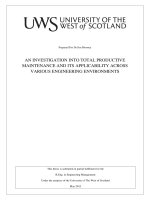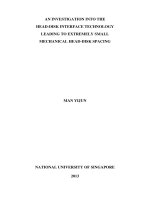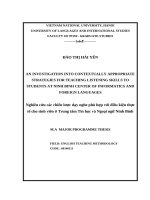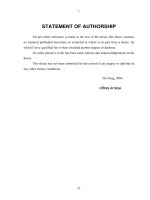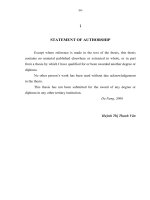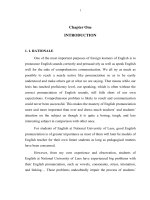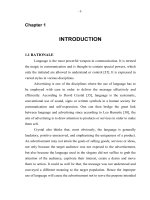An investigation into loss and gain in the translation of a comic the adventures of tintin tintin in america into vietnamese version nhung cuoc phieu luu cua tintin tintin tren dat my
Bạn đang xem bản rút gọn của tài liệu. Xem và tải ngay bản đầy đủ của tài liệu tại đây (1.23 MB, 26 trang )
MINISTRY OF EDUCATION AND TRAINING
THE UNIVERSITY OF DANANG
LÊ THỊ NHUNG
AN INVESTIGATION INTO LOSS AND GAIN IN THE
TRANSLATION OF A COMIC “THE ADVENTURES
OF TINTIN: TINTIN IN AMERICA” INTO
VIETNAMESE VERSION “NHỮNG CUỘC PHIÊU
LƯU CỦA TINTIN: TINTIN TRÊN ĐẤT MỸ”
Major: English Language
Code:
822.02.01
MASTER THESIS
IN LINGUISTICS AND CULTURAL STUDIES OF
FOREIGN COUNTRIES
(A SUMMARY)
Da Nang - 2020
The thesis has been completed at
THE UNIVERSITY OF ĐÀ NẴNG
Supervisor: TRẦN THỊ THUỲ OANH, Ph. D
Examiner 1: NGŨ THIỆN HÙNG, Ph. D
Examiner 2: TRƯƠNG BẠCH LÊ, Ph. D
The thesis was be orally defended at the Examining Committee
Field: English Linguistics
Time: July 03, 2020
Venue: The University of Da Nang
This thesis is available for the purpose of reference at:
-
The
Center
for
Learning
Information
Resources
and
- The Library of University of Foreign Language Studies,
The
Communication - The University of Da Nang
University of Da Nang
1
CHAPTER 1
INTRODUCTION
1.1. RATIONALE FOR THE STUDY
In the process of globalization today, English has been
considered an official language by many nations in the world and
used in many fields such as business, politics, economics, education
or communication. English is a language that enables people over the
world to express ideas or what is thought together. Consequently,
people learn how to make a good translation their own language into
English and vice versa. For instance, the comic The Adventures of
Tintin in French (Les Aventures de Tintin)
y
r
which has
attracted an extremely large amount of readers of the 20th century
(more than 200 million copies of the books sold to date) was
translated into English by Leslie and Michael (1978) and translated
from English version into Vietnamese by Nguyen Huu Thien (2016).
Actually, comic is an interesting and typical type of reading
containing a story series in pictures for many generations, not only
for chilren or young children.
Comic translators often get difficulties due to different
language and culture of countries. They should be able to choose the
simplest words to fit the capacity in the bubbles as well as have to
build their imagination by using the right words to bring readers to
get inside stories. To make a good translation of comic, one of the
strategies ususally used by translators is loss and gain. Therefore, in
order to help readers have deeply understanding comics in their
2
language, considering the loss and gain process in comic translation
should be carried out.
In this study, to clarify this strategy of loss and gain process,
one of the key issues in translation studies, we choose a comic called
The Adventures of Tintin by Belgian artist Georges (1907–1983)
wr t n un r t
p n n m o
r
which is one of the most
popular comics in the world and translated into more than 70
languages in which English version was performed by Leslie and
Michael (1978) and Vietnamese version (translated from this English
one) by Nguyen Huu Thien (2016). To serve the study, we used one
o t
popul r s r s o T nt n nt tl
“The Adventures of Tintin:
Tintin in America”. T s t tl w s wr tt n n 1931, pu l s
or t
first time in 1932, republished in 2002 by Herge New Edition and
said to the most interesting comic series. The author decided to use
this work due to the descriptive word usage and the rich of
utterances, which would be useful in analyzing how they will be
translated.
Moreover, the study in this area is still left and
untouched.
This encoura s us to con uct
stu y w t
t tl “An
investigation into loss and gain in the translation of the comic “The
adventures of Tintin: Tintin in America” into Vietnamese version
“Những cuộc phiêu lưu của Tintin: Tintin trên đất Mỹ” w t t
op
to clarify how the translation process of loss and gain works when
this comic is translated from English into Vietnamese.
3
1.2. THE AIM OF THE STUDY
- Clarify the generalizations of how the translating methods
are rendered and analyze the loss and gain when this comic is
translated from English into Vietnamese based on the semantic
features of lexicon of phrases and sentences.
- Identify the kind of loss and gain can be found in the
Vietnamese translation of English comic.
- Find the reasons why the translator should choose the loss
and gain process.
- Give some implications for r the learners and translator in
commic translating.
1.3. RESEARCH QUESTIONS OF THE STUDY
The research attempts to answer the following questions:
1).What are the semantic features of lexicon of phrases and
sentences of this comic translated into Vietnamese?
2). What kind of loss and gain can be found in the
Vietnamese translation version?
3). Why did the translators choose that loss and gain process
in translating a comic?
4). What are the implications for translators in comic
translating?
1.4. THE SCOPE OF THE STUDY
Due to limitation of duration and human sources, this study
focuses on the semantic features of lexicon of phrases and sentences
n t
com c “The Adventures of Tintin: Tintin in America” n
4
English and Vietnamese versions to find out loss and gain in the
translation .
1.5. THE SIGNIFICANCE OF THE STUDY
This study contributes to this growing area of research by
finding the loss and gain in translation of comic from English into
Vietnamese in order to help language users have a lot of information
about comic translating. This research sets out with an expectation
that many necessary adjustments have been made in helping to
decrease confusion when reading any kinds of English stories.
With the hope that the result of this study can give some
benefits to translators to enlarge knowledge about loss and gain and
to learn how to make a good translation analysis, especially in comic
translating.
1.6. THE ORGANIZATION OF THE STUDY
5
Chapter Two
LITERATURE REVIEW AND THEORETICAL
BACKGROUND
2.1. LITERATURE REVIEW
In Vietnam featured publications of this type include
Translation Books and Translation Courses by Bui and Dang (1999),
Translation Theory by Huynh and Nguyen (2000) and some scattered
academic essays found on the Internet., in Hướng dẫn kĩ thuật dịch
Anh – Việt (English –Vietnamese Translation Techniques) by
Nguyen (2005) and Le’s Translation and Grammar (2003). The
authors base their arguments on verified studies by well-known
scholars over the world and their scope of study is broad.
“An investigation into Loss and Gain in Vietnamese
Translation of English Lexical Nominalizations in American Short
Stories by Jack London and O’Henry” conducted by Le (2018) has
shown the ways of translating nominalizations and loss and gain in
the translation into Vietnamese. The thesis concluded that the
occurrence of the loss and gain of information in the process of
translation is caused by the structural differences in both languages.
In order to make the translation natural, the only way can be done is
to transfer the equivalence of the SL into the TL. Thus, the
occurrence is loss and gain process cannot be avoided due to
structure of the SL or linguistic system and cultural background are
different in the TL.
6
Next “An investigation into loss of meaning in the
translation process as manifested in the Vietnamese version of the
world is flat by Thomas L. Friedman” by Tran (2011) has explored,
described and analyzed the cases of loss in meaning occurred during
translation in English -Vietnamese translation of The World Is Flat.
The study showed her attention to the unavoidable phenomena in the
process of translation because of many reasons: the ability to use
language, the translation method choice of translator and the
difference of language. The most prominent reason may be the lastthe difference in language. It is this difference that affects the
translator’s equivalences. And loss in meaning will appear. In the
project, the researcher concluded that loss in meaning cannot be
considered the mistakes but the phenomena in the process of
translation each translator should be aware of in order to make his/
her product better. Clearly whatever kind of loss in meaning is, they
seem to be necessary because they can make the target version
smoother and the readers can find it more comprehensible and
acceptable.
Most of the writers only discussed the problems in syntactic
aspects and their semantic roles while the loss and gain in translation
by using the sematic strategies has not been fully mentioned.
Accordingly, a study of loss and gain in translation the comic by
using semantic strategies become a new item for language learners.
2.2. THEORETICAL BACKGROUND
2.2.1. The The main views of translation
7
2.2.1.1. Definition
2.2.1.2. The aspects of Language and Culture in Translation
2.2.1.3. Equivalence in translation
2.2.1.4. Translation procedures
2.2.1.5. Translation Strategy
2.2.1.6. Process of translation
2.2.2.
The main tenets of Comic
2.2.2.1. Definition
2.2.2.2. Comic translation
2.2.3. Loss and Gain
2.2.3.1. Loss
The generic differences in the two language systems
naturally generate loss on all levels. Baker (1992) refers to loss as
"omission of a lexical item due to grammatical or semantic patterns
of the receptor language" (p.40).
2.2.3.2. Gain
Gain, on the other hand, is very rare, if ever, because, as
Bassnett (2002) points out, translation theoreticians as well as
practitioners are mainly concerned with matters of equivalence. This
author also says that “ignoring what can also be gained, for the
translator can at times enrich or clarify the SL text
2.3. SUMMARY
8
Chapter Three
METHODOLOGY
3.1. RESEARCH METHODS
In order to achieve the purpose of the study, this thesis is
carried
out
with
a
considerable
concentration
on
mixed
methodologies, including qualitative method, quantitative method,
descriptive method, and contrastive method.
The qualitative method in this study is expressed in analyzing
the data consisting of loss and gain in translation by using translation
strategies, describing and discussing kinds of losses and gains found
both in SL and TL.
The descriptive method in the study is expressed in
describing the semantic features of lexicon features of words and
p r s so
t
com c “T
v ntur s o T nT n: T nt n n Am r cs‟s
English-version and Vietnamese-translated version.
The quantitative method in this study is firstly used in
collecting documents in Vietnamese and English Version. Secondly it
is used to count the number of loss and gain by using each translation
strategies. Charts and tables will be used to illustrate the popularity of
all strategies.
The contrastive method in this study is expressed in
comparing the similarities and differences, in terms of semantic
features of lexicon features of words and between the English and
Vietnamese translation to find out the loss and gain in translation of
this comic.
9
3.2. RESEARCH DESIGN
3.2.1. Data collection
T
t w r t k n rom
com c nt tl
of Tintin: Tintin in America” n En l s
Michael n V tn m s v rs on nt tl
“The Adventures
v rs on
y Leslie and
“Những chuyến phiêu lưu
của Tintin: Tintin trên đất Mỹ” y Nguyen Huy Thien. There are 690
utterances of the comic in English and Vietnamese versions.
3.2.2. Data analysis
- The English and Vietnamese version of the collected comic
c os n rom
com c s r s “The Adventures of Tintin: Tintin in
America” s s rc
to identify the utterances which influenced by
loss and gain in translated comic.
- The investigated utterances were classified and their
Vietnamese translation is examined to see how translation is
manifested.
- The data is compared between English and Vietnamese
version to identify types of loss and gain by using translation
strategies.
- The types of loss and gain based on translation strategies
are recognized; the occurrences of types of loss and gain are worked
out counted and presented in the tables.
- The result of the frequency was compared with each other
and shown in the charts.
3.3. RELIABILITY AND VALIDITY
In terms of reliability, All the data used for analysis and the
10
utterances are shown with clear and exact references about the
authors, name of publishers, time and place of the publication so we
assure that what is cited in this study would be exactly the same as it
appears in its original material. The data were collected from sources
which are reliable.
In the case of validity, the study was carried out on the basis
of the theoretical background of experienced linguists as mentioned
in Chapter Two and all findings in this thesis resulted from the
analysis of evidence, statistics and frequencies so the process of data
analysis leading to findings of the thesis is definitely valid.
3.4. SUMMARY
11
Chapter Four
FINDINGS AND DISCUSSION
4.1.THE DISCUSSION OF LOSS
4.1.1. Loss in Translation by Cultural Substitution
The researcher found that loss in translation by cultural
substitution appeared with 7 times and accounted for 6% in all
strategies.
Source language
Target language
Translation
Procedure
Alcatraz
and
sing Thật là xui xẻo, lũ Translation
sing! Dumb redskins mọ này sẽ k ôn
won‟t
t...
I‟v
gotta get out of here!.
đán
by
cultural substitution
ắn. Mìn p ả
c uồn t ô ”.
Based on translation by cultural substitution, the translator
used this strategy is to explicate the cultural context of the source and
target version. The different customs and traditions in the daily
activities and communications in Vietnam and Western countries
reflect the different cultural mentality. Loss is occuring.
Source language
Target language
Translation
Procedure
Great Manitou! Great
ỡ t ần l n c o cả! Translation
by
Manitou! Give victory hãy phù hộ cho con cultural substitution
to
your
(P.20)
warriors. cháu
n à
t ắn !(P.20)
c ến
12
The verb give means to offer something to someone, or to
provide someone with something and warriors refer to a soldier,
usually one who has both experience and skill in fighting, especially
nt
p st. Us n V tn m s wor s “đưa ra” n “ chiến binh”, t
translation will sound non –Vietnamese. Base on the cultural context
t
tr nsl tor c oos t
wor s “ phù hộ” n
“con cháu” to su t
Vietnamese cultural mentality.
4.1.2. Loss in Translation by using Paraphrase with Unrelated Word
The loss in translation by using paraphrase with unrelated
word, with 4 times of appearing and 3% of the total proportion of all
strategies is the lowest in translation the comic.
Source language
Target language
Translation
Procedure
They
mean
m ….qu ck,
to
kill C ún
muốn
my mìn .
P ả
handkerchief (P.12)
ết Translation
đ o using
khẩu trang thôi! with
(P.12)
by
paraphrase
unrelated
word.
The translator chooses to use translation by using paraphrase
with unrelated word. “Handkerchief” coul
qu v l nt “khăn mùi soa” w c m ns
t t
Vietnamese
sm ll usu lly squ r p c
of cloth used for usually personal purposes (such as blowing the nose)
or as a clothing accessory. Especially, most of the readers are children
so that the loss orginal meaning shown in the data above is to look for
the appropriate word to make the translation in the target language
simpler, familar and easier to be read by the readers.
13
Source language
Target language
Translation
Procedure
I have a feeling we Mình t ấy n ư mìn Translation by using
look a bit out of place mặc đồ quê quá paraphrase
with
here, Snowy (P.16)
Snowy ạ (P.16)
unrelated word.
As in dictionary the phrase out of place refers to a setting where
one is or feels inappropriate or incongruous. Howerver the translator uses
translation by using paraphrase with unrelated word to convey this phrase
into Vietnamese is mặc đồ quê quá nst
o “lạc lõng”.
4.1.3. Loss in translation by using omission
The researcher found that this kind of loss appeared with the
highest appearances: 82 times in Vietnamese and accounted 73%.
Source language
Target language
Translation
Procedure
Just keep still, Snowy, N ồ
yên
nhé,
and on‟t
r t n
Snowy, đừn
sợ
(p.2)
mà”. (p.2)
Translation by
omission
It can be shown that the translator did not translate the word
“and” from SL into TL. The translator did the process that way
because by losing the word “and”, the target language text sounds
more natural and acceptable by the readers. It does not make any
difference if the translator losses that word.
Source language
Target language
“You kidnapped me! “Địn ắt cóc tô à?
Come on...Why?” (P.3)
Để làm ì
vậy?”(P.3)
Translation
Procedure
Translation by
omission
14
The researcher finds t
p r s “come on” s oun
nt
SL,
but it is not translated in the TL by the translator. Based on this
information, the researcher concludes that the translator purposely
lost t
p r s “come on” to
t a natural translation, so it can be
more comfortable to be read by the readers.
Source language
Target language
Translation
Procedure
“You‟r
r v
llow, Cậu
Snowy...and clever! (P.9)
cừ
lắm, Translation
Snowy ạ (P.9)
by
omission
In the table above, it can be seen that the phrase “and clever”
is omitted. It happens because the translator considered the space
limit to put some more words in the bubble.
4.1.4. Loss in translation by using A More Neutral/Less
Expressive Word
This type of loss appears eight times with 7% and stands on
the second rank in all strategies used.
Source language
An
Target language
t t‟s or you. Đây là củ
Translation Procedure
n . translation by using a
Now just get that G ờ t ì thanh toán more
little squirt out of my t ằn n ã đó đ , t
hair,
permanently! k ôn
(P.5)
neutral/less
expressive word
muốn t ấy
mặt nó nữ ! (P.5)
Example above shows that the words “get out” is translated
into “thanh toán”. The translator chooses to apply translating by
us n mor n utr l/l ss xpr ss v wor . T
wor “get out of my
15
hair” s us
In t
to mp s z t t to stop
V tn m s v rs on, t
n
nu s nc to som on .
tr nsl tor us s t
wor “thanh toán”
– which does not fully express the meaning, but the general meaning
is partly transferred and conveyed.
Source language
Target language
Translation
Procedure
Sorry I c n‟t st y; ot Tô
p ả
đ
y, translation by using a
three more clients to còn vài ba vụ nữ
take
care
of
morn n ….so
more
neutral/less
this p ả làm sán n y. expressive word.
lon
Chào nhé (p.14)
(p.14)
The data shows how the word “clients” is translated into “vụ”.
The translator chooses to use translation by using a more neutral/less
expressive wor . “Clients” coul
“khách hàng” w c m ns
t t
V tn m s
p rson w o us s t
qu v l nt
s rv c s or
vc
of a professional person or organization. In contrast, the translator
c oos s “vụ” nst
o us n “khách hàng”. when the translator use
vụ as an equivalent for clients, they lost their reflected meaning.
4.1.5. Loss in translation by a more general word
Loss in translation by a more general word accounted for 5 %
of all type of loss with 5 times.
16
Source language
Target language
Translation
Procedure
Let
my
warriors
young Người củ
drag
him kéo
from hole. (P.27)
T
xác
tô
nó
sẽ translation
by
a
lên more general word
(P.27)
tr nsl tor us s “người”,
mor
n r l wor
(superordinate) or a more commonly known to replace the more
specific on . “warriors” coul
binh” w c r
rs to
sol
tt
V tn m s
r, usu lly on w o
qu v l nt “chiến
s ot
xp r nc
and skill in fighting.
Source language
Target language
Translation
Procedure
He knocked out the Dám chơi cả ôn
boss and Pietro too!
translation
by
a
c ủ và t ằn P tro more general word
nữ !
The pharse “knocked out” is translated into target language is
“ chơi” nst
o “hạ gục” y us n tr nsl t on y
mor
n r l
word. The pharse knocked out refer to make someone become
unconscious, usually by hitting them on the head. However the word
“ chơi” n TL means to compete against (someone) in a game. In this
case the original meaning is loss.
4.1.6.
Loss in translation by using loan word without
explanation
Loss in translation by using loan word without explanation is
appeared 6 times with 6.4% in all strategies used.
17
Source language
Look!
Target language
Translation Procedure
A N ìn kì ! Một cá
Translation by using
boomerang!
bu-mê-răng!
loan
word
without
explanation
T
n w
t ms
s “boomerang” must
t orou ly
explained. Hence, after using the loan word, the translator needs to
include an explanation so that reader can better understand. ,
“boomerang” s
scr
p rt cul r w y, com s
s “ curv
ck to t
t t “ oom r n c n
Source language
gangster
p rson w o t r w t” ut t c n
us
or n m l unt n ”.
Target language
I must find that
out…w t
st ck t t, w n t rown n
out t
Translation Procedure
y là ắn, cá tên Translation by using
găngxto đ n
ị t
I‟m truy đuổ ? (P.23)
loan
word
without
explanation
chasing? was it him?
(P.23)
The translator kept the orginal text o t
wor “gangster”
instead of translating the word into Vietnamese. The translator simply
uses translation by using loan word to evoke the traditional
atmosphere of the source text culture.
4.2. THE DISCUSSION OF GAIN
4.2.1. Gain in Translation by using Paraphrase with Related Word
The researcher found that gain in translation by using
paraphrase with related word appeared with the higher appearances:
17 times and accounted for 81% in all.
18
Source language
Target language
Translation Procedure
Trust me to be in the Ở nơ xe máy, xe Translation
land
of
the hơi ầm ầm mà phái paraphrase
automobile
have
and cuốc ộ mườ
to slog ten
miles on foot! (P.2)
by
using
a
ặm! related word
uồn cườ t ật! (P
.2)
The paraphrase conveys explanation on the word automobile
of the ST.
The translator chooses to use the phrase “xe máy, xe hơi ầm
ầm” to emphasize the feeling of the man named Tintin when he have
to slog ten miles on foot in the land of automobile.The translator feels
the need to compensate the possible loss by enriching the term as the
t r t t xt r
rs‟ conc pt on “xe máy và ô tô” is the focus of the
comic to helps the TT readers to gain more information.
Source language
What
Target language
Translation Procedure
happened? C uyện ì vậy? Oo , Translation
Ooh. Have I got a sao đầu mình nhức paraphrase
headache! (P.51)
như búa bổ. (P.51)
by
using
a
related word
Due to the absence of a Vietnamese equivalent word for a
already known concept, it is the chance for a translator to paraphrase
t s “đầu nhức như búa bổ”, w c
v n w ll pro uc
ut ul
expression.
4.2.2. Gain in Translation by using Paraphrase with Unrelated Word
The number of
gain in by using translation by using
paraphrase with unrelated word appeared 4 times in the translated
19
comic. This strategy has the portion of 19% of the total. The
examples below will make it clearer:
Source language
Target language
Translation Procedure
The attacker, Sir, Đồ dữ như quỷ sứ. Translation
hit me over the head Đập u đầu tô rồ
with
a
Javanese c ứ
by
paraphrase
using
ỡn đâu. (P.46) unrelated word
club. (P.46)
The data of the data above shows how skillful the translator is
to build an equivalence that can best describe the word “attacker” has
been commonly used with the meaning “ p rson w o urts or tr s to
urt som on ”.
In this data the translator replaces the word
“attacker” with “đồ dữ như quỷ sứ”. Using Vietnamese words
“Người tấn công”, t
tr nsl t on w ll soun
non –Vietnamese.
Paraphrasing it by a combination of Vietnamese items has brought
out an acceptable translation in common sense.
Source language
Target language
Translation Procedure
Gosh, Snowy, that May mà có hồ Translation
was close (P.39)
by
nước, không thì paraphrase
tiêu rồi! (P.39)
using
unrelated word
It can be seen that,in this data the translator replaces the
cl us “that was close” y “may có hồ nước”. t
close” unknow to t
p r p r s
t
understanding.
cl us
r
r n TT, t r or , t
cl us “ that was
tr nsl tor
c
s to
to “ may có hồ nước” n or r to
tt r
20
4.3. FREQUENCY OF LOSS AND GAIN IN TRANSLATION
BY USING SEMANTIC TRANSLATION STRATEGIES
We found that there are 7 strategies most used that affacted to
loss and gain in translation and their frequency is illustrated in the
table below:
Table 4.1 The quantity and percentage of loss in translation by using
semantic strategies
Type of loss
Quantity
Percentage
7
6
with Unrelated Word
4
3
Loss in translation by using omission
82
73
Neutral/Less Expressive Word
8
8
Loss in translation by a more general word
6
5
6
5
113
100
Loss
in
Translation
by
Cultural
Substitution
Loss in Translation by using Paraphrase
Loss in translation by using A More
Loss in translation by using loan word
without explanation
Total
21
5%
8%
5% 6%
Loss by Cultural
Substitution
3%
Loss by using Paraphrase
with Unrelated Word
Loss by using omission
73%
Chart 4.1. The percentage of loss in translation by using semantic
strategies.
By examining the frequency of those types of loss, loss in
translation by omission is most used with over a haft of proportion.
Table 4.2 The quantity and percentage of gain in translation by using
semantic strategies
Type of gain
Gain
in
Translation
Quantity
by
using
Paraphrase with Related Word
Gain
in
Translation
by
Paraphrase with Unrelated Word
Total
Percentage
17
81
4
19
21
100
using
22
Gain by using
paraphrase with
related word
19%
81%
Gain by using
paraphrase with
unrelated word
Chart 4.2. The percentage of gain in translation by using
semantic strategies.
4.4. SUMMARY
23
Chapter Five
CONCLUSION AND IMPLICATIONS
5.1. CONCLUDING REMARKS
Firstly, the researcher found 134 processes of loss and gain with
113 patterns of loss and 21 patterns of gain in the translation process
of the comic by using semantic strategies.
Secondly, the reason why the translator did the loss and gain
process in translating the comic is the translator wanted to make a
good translation that sounds natural and acceptable by the readers.
Besides that, comic books represent not only the typical constraints
of language but also space limitations. Thus, the occurrence is loss
and gain process cannot be avoided due to structure of the SL or
linguistic system and cultural background are different in the TL.
Translation is a process of decision-making, and thus translators in
rendering texts from SL to TL tend to make their choices of language
use. Choosing words to convey meaning seems to be challenging due
to the selection of the word based on the background of language
they were exposed to and also the context of the text.
Finally, the researcher concludes that the translation result of the
com c „The Adventures of Tintin: Tintin in America” nto “Những
chuyến phiêu lưu của Tintin: Tintin trên đất Mỹ” s n tur l n
acceptable.
5.2. IMPLICATIONS FROM THE RESULTS
5.2.1. To teachers
For teachers, while teaching translation, teacher should

